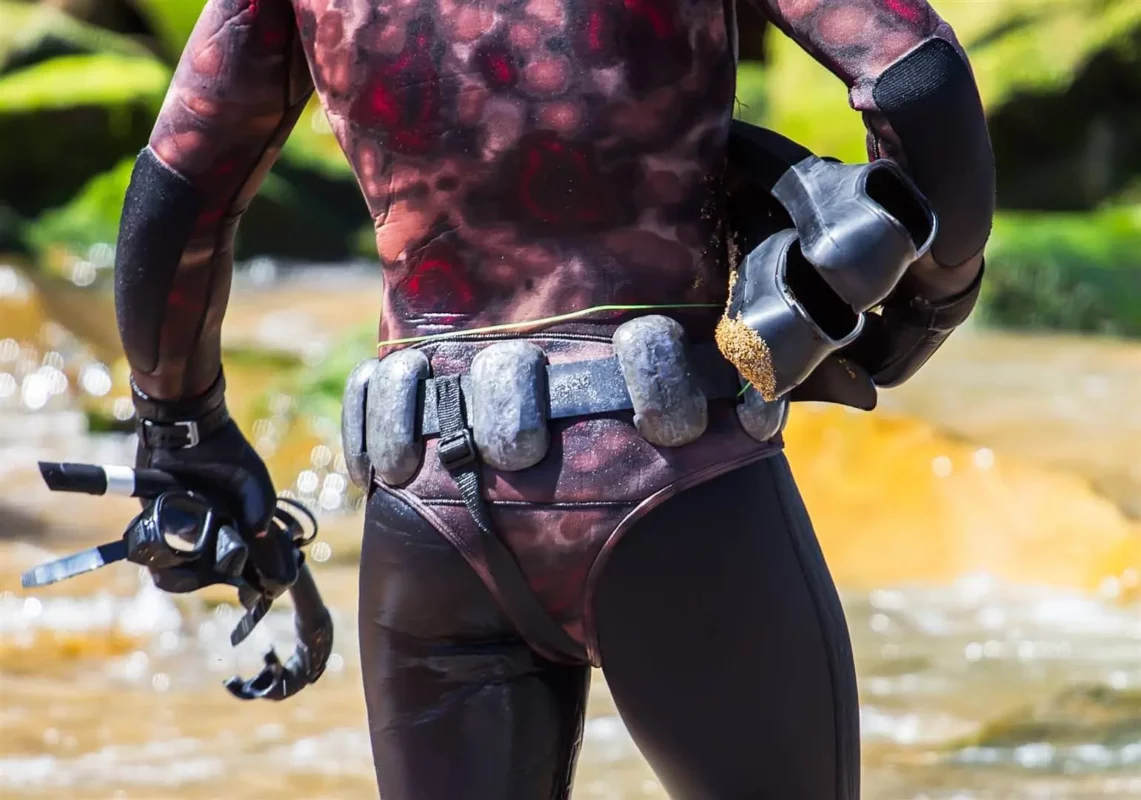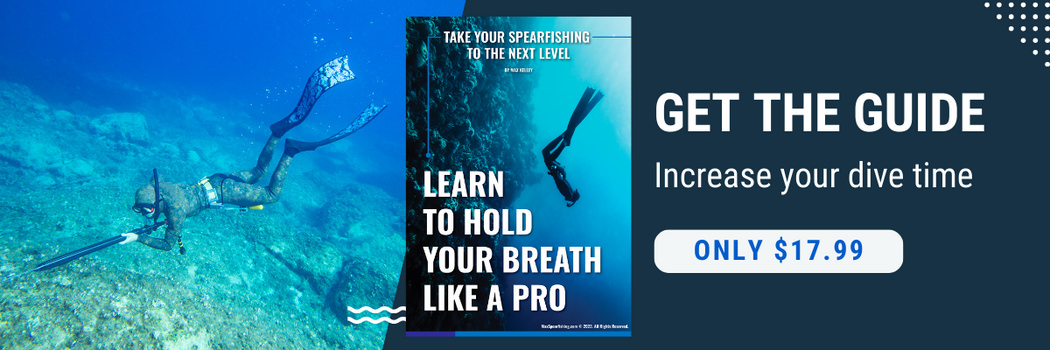No products in the cart.
Spearfishing Gear
The correct way to setup a spearfishing weight belt
One of the most important pieces of gear you need is a spearfishing weight belt. When I’m spearfishing, I almost always wear a wetsuit to stay warm, but this can make spearfishing a little tricky.
Because your wetsuit will cause you to float. And if you’re sporting a proper spearfishing wetsuit, you’re going to struggle even getting yourself to the bottom. Let alone staying down there to spearfish. That’s why you need a weight belt for spearfishing.
Max Spearfishing is reader-supported. We may earn a small commission for purchases using our links. Click here to learn more.
The correct way to setup a spearfishing weight belt
In short, a spearfishing weight belt works to offset the buoyancy of your wetsuit, so you’re able to dive down to the hunting zone. Because your weight belt is heavy, it counteracts the floatation of your wetsuit.
The trick is to get it right.
But this is harder than it seems. Because there’s just so many variables.
- The salinity of the water will affect your buoyancy.
- The thickness of your wetsuit will affect your buoyancy.
- The depth you’re planning to dive will affect your buoyancy.
- The composition of your body will affect your buoyancy.
What you want to achieve, is to add the perfect amount of lead to your weight belt. So you can dive down to the hunting zone effectively. I say effectively, because you need to remember that getting back to the surface is rather important too, especially once you need to breathe again.
Putting a huge amount of spearfishing weights on your weight belt would make it easy to hit the bottom, but it’s going to be very difficult swimming back to the surface. If not fatal. The key is to find the balance where it’s relatively easy to get to the bottom, and also to kick back to the surface.
How much lead to use on a weight belt for spearfishing
The first step is to get neutrally buoyant in the water.
This basically just means, you’re able to hang in the water without floating or sinking. The ideal depth you want to be neutrally buoyant at is about 8 meters deep.
There’s a few reasons for this.
Inside your wetsuit are tiny bubbles of gas. As you dive, the pressure from the water around them causes these bubbles to compress, so you become less buoyant. After 8 meters, you want your buoyancy to fall, so it’s simple to drop down to the bottom.
But there’s also safety. We talk about the risk of shallow water blackouts in a number of posts, and there’s a reason we want to be positively buoyant above 8 meters. Just in case you blackout, the buoyancy in your wetsuit will bring you straight up to the surface.
Of course, you’re going to need to adjust the weight you need to use depending on the depth you’re diving. When I’m in close along the reefs in shallow water I have to add more weight to ensure I stay on the bottom.
Just be very careful.
On the surface of the water you want to be positively buoyant. You want to float. If you add too much weight and you’re not able to float comfortably on the surface, this can get deadly very quickly. As soon as you’re tired and not kicking to stay afloat, you’ll sink.
Getting the right amount of lead on your spearfishing weight belt is critical.
Of course, people are different and they’re going to need to adjust this, but to give you an example for me, at 84kg, I use 7kg of weights along with my 5.5mm wetsuit.
As a general rule, to find the amount of weight you need take the thickness of your wetsuit then + 2 to get a starting point. For example:
- A 3mm wetsuit = 3 + 2 = 5kg of weight
- A 5mm wetsuit = 5 + 2 = 7kg of weight
Now these are only rough guidelines, and assuming you’re an average of about 80kg. If you’re lighter than this, I’d add on 1.5 kg of weight instead of two, or if you’re heavier add on 2.5 kg of weight.
Also, if you’re new to the sport of spearfishing I’d recommend keeping your weights a kilogram or two lighter until you’re used to your equipment and starting to get confident diving to the bottom to spearfish. Only once you’ve got it down should you start working to get your neutral buoyancy right. It pays to err on the side of caution with spearfishing, and make sure you’ve got a buddy with you when you’re testing a spearfishing weight belt.
Finally, I want to make one final note about buoyancy. As you dive deeper and deeper the air in your lungs compresses, along with your wetsuit. To the point where you’re no longer buoyant in the water. Here is where you need to be very aware, as past this point you’re not going to have any help getting back to the surface. You won’t float.
When I’m on the bottom in 20 meters of water, I have to physically swim back to the 8 meter mark before the buoyancy of my wetsuit kicks in and I get a little help floating to the surface.
What’s your spearfishing weight belt made from?
In addition to the lead weights, the two most important parts of your spearfishing weight belt are what it’s made from and the buckle.
Always, always, choose a weight belt for spearfishing with a quick-release buckle. If there’s an emergency, you want to be able to drop the weight belt as quickly as possible so you float right back to the surface. Riffe make one of the best weight belts I’ve seen, and its also rubber.
No products found.
Now, if you’ve done any scuba diving you’ve probably seen the cheap nylon belts that get used instead of rubber. This is fine when you’re diving with a tank, because you’re much more stable in the water, and it’s usually stuck in place below your BCD and wedged between your tanks. Plus, you’re breathing tank air so you’re not getting your torso compressed by the pressure, and you’re not flipping upside down to dive to the bottom.
But when you’re spearfishing, I’ve found that nylon weight belts are just too slippery. They slide from side to side when you’re moving through the water, and when you duck-dive down they slip up from your hips to your stomach and you’ve got to waste time readjusting it on almost every dive. It’s not fun.
My advice is to spent a little bit extra for a rubber spearfishing weight belt. The rubber won’t slip, and you won’t need to wear it that tight either. It’s more expensive yes, but it’s a better piece of gear.
Testing your spearfishing weight belt
Once you’ve got your weight belt setup, it’s relatively easy to test your buoyancy.
Get kitted out in all your spearfishing gear, and allow yourself to float vertically in the water. Be totally relaxed, with your fins pointing down and your arms at your side. If you’ve calculated and got your setup right, the water should be coming about halfway up your face.
- If your mouth is out of the water, you’ve not got enough weights on your belt.
- If your being pulled under and the water is above your head, you’ve got too much weight on.
Make any adjustments to your weight belt as you need, then you’re ready for the next step. It’s time to start diving.
From here, I’d do a few test dives to 8 meters. My dive watch shows me how deep I’m going, but you could always mark off the depth on your floatline and follow it down. You should be able to hover in the water at the 8 meter mark without sinking or floating.
If you’re not sure,
- Kick up to 7 meters and see if you start floating, then,
- Kick down to 9 meters and see if you start sinking
Make any adjustments to your weights as you need until you’re neutrally buoyant at the 8 meter mark. That’s your ideal weight. Remember this number.
Now, it’s just a matter of adjusting to your conditions.
- If you’re going to be diving in shallow, rough water, I’d add weight until you’re able to lie flat on the bottom without floating back to the surface.
- If you’re going to be diving deep, I’d remove the weights so you’ve got to work a little harder to push past a deeper “neutrally buoyant” zone, but this will make it far easier to float to the surface when you’re running out of air.
Setting up your spearfishing weight belt is one of the most important fundamentals of the sport to get right. Being able to dive to the bottom is critical for hunting fish, as is your ability to stay down there and maximize your time spearfishing. Just be careful to get it right, do your testing and work out the perfect amount of lead to add. You don’t want to be fighting to return to the surface for every breath.
Happy spearin’


